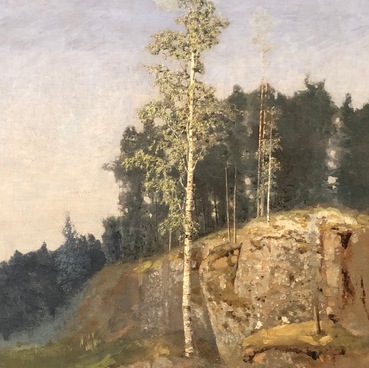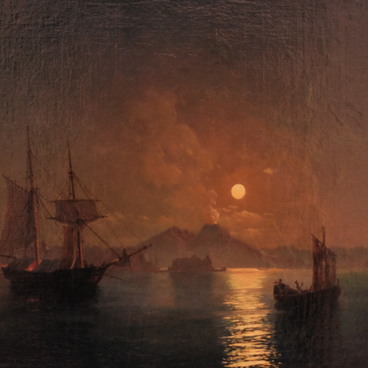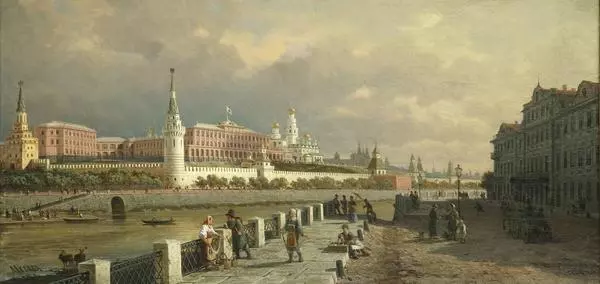Pyotr Vereshchagin painted The Mosque at the end of the 19th century. Experts tend to identify it with the mosque Bibi-Khanum in Samarkand, Uzbekistan, built in the early 15th century by the order of Tamerlane to celebrate his victorious Indian campaign. The name Bibi-Khanum means ‘Elder Princess’. It is believed to have been named after the conqueror’s favorite wife.
Vereshchagin painted the mosque on a hot sunny day. Light ochre shades contrast with brightly lit walls. Near the entrance there is a man standing motionlessly under the baking sun, probably keeping a watch on the door. The artist made the man’s figure and his traditional ethnic clothing look very convincing.
Pyotr Vereshchagin chose vertical format for the canvas. He painted Bibi-Khanum from the actual viewpoint of a passer-by. This composition gives the viewer the impression of actually being in Samarkand.
The artist painstakingly reproduced elaborate ornaments of the mosque – geometrical, floral and epigraphic (readable inscriptions made to resemble decorative patterns). In addition, architecture is adorned with carved mosaic and majolica (burned clay painted over with colored glaze). Majolica pieces alternate with unglazed bricks.
Pyotr Vereshchagin lived and worked in St. Petersburg but traveled often. When traveling he would paint studies of Moscow, Kiev, Sebastopol, Nizhny Novgorod, Crimea, and the Caucasus. He was the first to put the middle Urals on canvas.
Vereshchagin was famous for his natural and architectural landscapes painted in the academic manner. He aimed for perfect linear perspective reproducing landscapes in true proportion. Alongside academic rules he used techniques which were quite innovative. Unlike many other landscapists of the mid-19th century, he gave up neutral staffage — inclusion of unimpressive human and animal figures. Seeking to add life to the picture, Vereshchagin painted scenes from everyday life based on observations he made during his travels.
Vereshchagin painted the mosque on a hot sunny day. Light ochre shades contrast with brightly lit walls. Near the entrance there is a man standing motionlessly under the baking sun, probably keeping a watch on the door. The artist made the man’s figure and his traditional ethnic clothing look very convincing.
Pyotr Vereshchagin chose vertical format for the canvas. He painted Bibi-Khanum from the actual viewpoint of a passer-by. This composition gives the viewer the impression of actually being in Samarkand.
The artist painstakingly reproduced elaborate ornaments of the mosque – geometrical, floral and epigraphic (readable inscriptions made to resemble decorative patterns). In addition, architecture is adorned with carved mosaic and majolica (burned clay painted over with colored glaze). Majolica pieces alternate with unglazed bricks.
Pyotr Vereshchagin lived and worked in St. Petersburg but traveled often. When traveling he would paint studies of Moscow, Kiev, Sebastopol, Nizhny Novgorod, Crimea, and the Caucasus. He was the first to put the middle Urals on canvas.
Vereshchagin was famous for his natural and architectural landscapes painted in the academic manner. He aimed for perfect linear perspective reproducing landscapes in true proportion. Alongside academic rules he used techniques which were quite innovative. Unlike many other landscapists of the mid-19th century, he gave up neutral staffage — inclusion of unimpressive human and animal figures. Seeking to add life to the picture, Vereshchagin painted scenes from everyday life based on observations he made during his travels.







